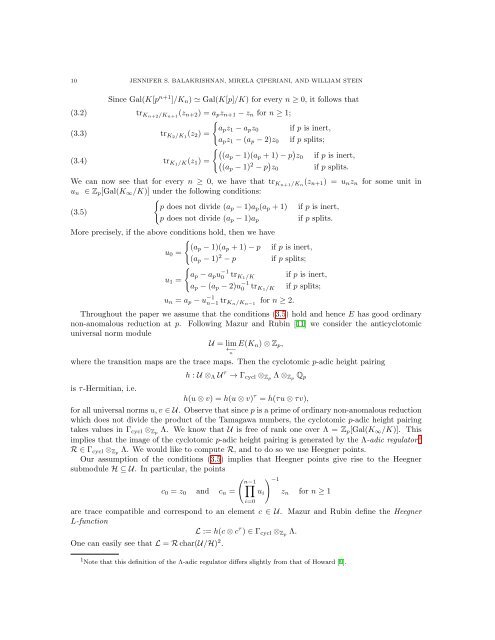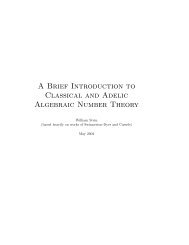p-ADIC HEIGHTS OF HEEGNER POINTS AND ANTICYCLOTOMIC ...
p-ADIC HEIGHTS OF HEEGNER POINTS AND ANTICYCLOTOMIC ...
p-ADIC HEIGHTS OF HEEGNER POINTS AND ANTICYCLOTOMIC ...
Create successful ePaper yourself
Turn your PDF publications into a flip-book with our unique Google optimized e-Paper software.
10 JENNIFER S. BALAKRISHNAN, MIRELA ÇIPERIANI, <strong>AND</strong> WILLIAM STEIN<br />
(3.2)<br />
(3.3)<br />
(3.4)<br />
Since Gal(K[p n+1 ]/Kn) Gal(K[p]/K) for every n ≥ 0, it follows that<br />
trKn+2/Kn+1 (zn+2) = apzn+1 − zn for n ≥ 1;<br />
<br />
apz1 − apz0 if p is inert,<br />
trK2/K1 (z2) =<br />
apz1 − (ap − 2)z0 if p splits;<br />
<br />
(ap − 1)(ap + 1) − p<br />
trK1/K(z1) =<br />
z0 if p is inert,<br />
<br />
(ap − 1) 2 − p z0 if p splits.<br />
We can now see that for every n ≥ 0, we have that tr Kn+1/Kn (zn+1) = unzn for some unit in<br />
un ∈ Zp[Gal(K∞/K)] under the following conditions:<br />
<br />
(3.5)<br />
p does not divide (ap − 1)ap(ap + 1)<br />
p does not divide (ap − 1)ap<br />
if p is inert,<br />
if p splits.<br />
More precisely, if the above conditions hold, then we have<br />
<br />
u0 =<br />
(ap − 1)(ap + 1) − p<br />
(ap − 1)<br />
if p is inert,<br />
2 − p if p splits;<br />
u1 =<br />
<br />
ap − apu −1<br />
0 tr K1/K if p is inert,<br />
ap − (ap − 2)u −1<br />
0 tr K1/K if p splits;<br />
un = ap − u −1<br />
n−1 tr Kn/Kn−1<br />
for n ≥ 2.<br />
Throughout the paper we assume that the conditions (3.5) hold and hence E has good ordinary<br />
non-anomalous reduction at p. Following Mazur and Rubin [11] we consider the anticyclotomic<br />
universal norm module<br />
U = lim E(Kn) ⊗ Zp,<br />
←−<br />
n<br />
where the transition maps are the trace maps. Then the cyclotomic p-adic height pairing<br />
is τ-Hermitian, i.e.<br />
h : U ⊗Λ U τ → Γcycl ⊗Zp Λ ⊗Zp Qp<br />
h(u ⊗ v) = h(u ⊗ v) τ = h(τu ⊗ τv),<br />
for all universal norms u, v ∈ U. Observe that since p is a prime of ordinary non-anomalous reduction<br />
which does not divide the product of the Tamagawa numbers, the cyclotomic p-adic height pairing<br />
takes values in Γcycl ⊗Zp Λ. We know that U is free of rank one over Λ = Zp[Gal(K∞/K)]. This<br />
implies that the image of the cyclotomic p-adic height pairing is generated by the Λ-adic regulator 1<br />
R ∈ Γcycl ⊗Zp Λ. We would like to compute R, and to do so we use Heegner points.<br />
Our assumption of the conditions (3.5) implies that Heegner points give rise to the Heegner<br />
submodule H ⊆ U. In particular, the points<br />
c0 = z0 and cn =<br />
n−1<br />
<br />
i=0<br />
ui<br />
−1<br />
zn for n ≥ 1<br />
are trace compatible and correspond to an element c ∈ U. Mazur and Rubin define the Heegner<br />
L-function<br />
L := h(c ⊗ c τ ) ∈ Γcycl ⊗Zp Λ.<br />
One can easily see that L = R char(U/H) 2 .<br />
1 Note that this definition of the Λ-adic regulator differs slightly from that of Howard [9].
















